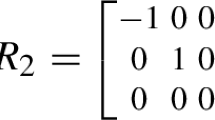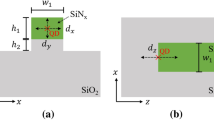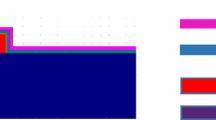Abstract
The main goal of this paper is the discussion of the energy transfer mechanisms between two concentric waveguides. An analytical model is developed for the electromagnetic propagation in two coupled concentric semiconductor waveguides. This model includes the calculation of the semiconductor refractive index taking into account the carrier densities, temperature and frequency. The model allows the analysis of the mechanisms of energy transfer between the two waveguides. As expected two types of energy loss are present, one related to the curvature of the waveguides and the other related to the absorption of the radiation in the semiconductor. Finally, the analyzed structure was optimized with regards to the above parameters.






Similar content being viewed by others
References
Absil, P.P., Hryniewicz, J.V., Little, B.E., Cho, P.S., Wilson, R.A., Joneckis, G., Ho, P.T.: Wavelength conversion in GaAs micro-ring resonators. Opt. Lett. 25, 554–556 (2000). doi:10.1364/OL.25.000554
Aspnes, D.E., Kelso, S.M., Logan, R.A., Bhat, R.: Optical properties of AlxGa1−xAs. J. Appl. Phys. 60, 754–767 (1986). doi:10.1063/1.337426
Bányai, L., Koch, S.W.: A simple theory for the effects of plasma screening on optical spectra of highly excited semiconductors. Z. Phys. B Condens. Matter 63(3), 283–291 (1986). doi:10.1007/BF01303807
Bykov, D.V., Silichev, O.: Laser Resonators. Cambridge International Science Publishing, United Kingdom (1995)
Cao, H., Liu, C., Deng, H., Benavidez, M., Smagley, V., Caldwell, R., Peake, G., Smolyakov, G., Eliseev, P., Osinski, M.: Frequency beating between monolithically integrated semiconductor ring lasers. Appl. Phys. Lett. 86(4), 041101 (2005). doi:10.1063/1.1853532
Dixit, K.: Filtering Resonators. Nova Science Publishers Inc, United States (2001)
Grover, R., Ibrahim, T.A., Ding, T.N., Leng, Y., Kuo, L.C., Kanakaraju, S., Amarnath, K., Calhoun, L.C., Ho, P.T.: Lateral coupled InP-based single-mode microracetrack notch filter. IEEE Photon. Technol. Lett. 15(8), 1082–1084 (2003). doi:10.1109/LPT.2003.815335
Hagness, S.C., Rafizadeh, D., Ho, S.T., Taflove, A.: FDTD Microcavity simulations: design and experimental realization of waveguide-coupled single mode ring whispering-gallery-mode disk resonators. IEEE J. Lightwave Technol. 15(11), 2154–2165 (1997). doi:10.1109/50.641537
Hall, D., Jackson, P.: The Physics and Technology of Laser Resonators. Taylor Francis Ltd, United Kingdom (1989)
Haug, H., Koch, S.W.: Semiconductor laser theory with many-body effects. Phys. Rev. A 39(4), 1887–1898 (1989). doi:10.1103/PhysRevA.39.1887
Hiremath, K.R., Hammer, M., Stoffer, R., Prkna, L., Ctyroky, J.: Analytic approach to dielectric optical bent slab waveguides. Opt. Quant. Electron. 37(1), 37–61 (2005).doi:10.1007/s11082-005-1118-3
Kudryashov, A., Weber, H.: Laser Resonators: Novel Design and Development. SPIE–The International Society for Optical Engineering, United States States of America (1999)
Liao, A.S., Wang, S.: Semiconductor injection lasers with a circular resonator. Appl. Phys. Lett. 36(10), 801–803 (1980). doi:10.1063/1.91321
Lindberg, M., Koch, S.W.: Effective bloch equations for semiconductors. Phys. Rev. B 38(5), 3342–3350 (1988). doi:10.1103/PhysRevB.38.3342
Macek, W.M., Davies, D.T.M.: Rotation sensing with travelling wave ring lasers. Appl. Phys. Lett. 67(2), 67–68 (1963). doi:10.1063/1.1753778
Marcatili, E.A.J.: Bends in optical dielectric guides. Bell Syst. Tech. J. 48(7), 2103–2132 (1969). doi:10.1002/j.1538-7305.1969.tb01167.x
Rabus, D.G., Hamacher, M., Heidrich, H.: High Q channel dropping filters using ring resonators with integrated SOAs. IEEE Photon. Technol. Lett. 10, 1442–1444 (2002). doi:10.1109/LPT.2002.802375
Rafizadeh, D., Zhang, J.P., Hagness, S.C., Taflove, A., Stair, K.A., Ho, S.T.: Temperature tuning of microcavity ring and disk resonators at 1.5 μm. In: Proceedings of the IEEE LEOS Annual Meeting, pp. 162–163 (1997).doi:10.1109/LEOS.1997.645327
Rosenthal, A.H.: Regenerative circular multiple-beam interferometry for the study of light-propagation effects. J. Opt. Soc. Am. 52(10), 1143–1148 (1962). doi:10.1364/JOSA.52.001143
Torres, J.: Laseres em anel semicondutor. Ph.D. Thesis, Technical University of Lisbon (2014)
Torres, J., Baptista, A., Machado, V.M.: Coupling analysis in concentric ring waveguides. IEEE J. Lightwave Technol. 31(13), 2140–2145 (2013). doi:10.1109/JLT.2013.2263633
Varshni, Y.P.: Temperature dependence of the energy gap in semiconductors. Physica (Utrecht) 34(1), 149–154 (1967). doi:10.1016/0031-8914(67)90062-6
Acknowledgments
This work was supported by national founds through the Fundação para a ciência e a Tecnologia (FCT) of the Portuguese Government through IT with reference UID/EEA/50008/2013.
Author information
Authors and Affiliations
Corresponding author
Appendix
Appendix
The dielectric constant of the waveguide is a function of the carrier densities in the semiconductors. As a consequence, the propagation constant of the waveguide also depends on the carrier densities.
In a more generic way the Eq. (3) can be written as:
The summation has two contributions, one associated with bound states and another with continuous states, and can be written as:
where \(g = \frac{12}{{\pi^{2} a_{0} k_{s} }}\), \(\delta_{T} \left( x \right) = \frac{1}{{\pi T{ \cosh }\left[ {\frac{x}{T}} \right]}}\), \(x = \frac{{W_{k} }}{kT}\), \(a_{0} = \frac{{\hbar^{2} {\mathcal{E}}_{0} }}{{mq^{2} }}\) is the Bohr radius, u α is Fermi level for electrons (α = e) and holes (α = h), m α is the electron effective mass if α = e and for holes if α = h, \(m^{ - 1} = \sum\nolimits_{\alpha } {m_{\alpha }^{ - 1} }\) and r cv is the element of the transition matrix in the direction of the electric field.
The screening length is determined by:
where \({\text{f}}_{{{\upalpha }}}\) is the usual Fermi function for free electrons and holes.
The Fermi level for electron and holes is given by:
where N α is the carrier density.
The results of the paper where obtained with the parameters:
m α = 0.0665 m 0, m h = 0.52 m 0, W R = 0.0042 eV, m 0 = 9.109 × 10−31kg, W G = 1.424 eV, q = 1.602 × 10−19 C
The real part of the dielectric constant, \(\varepsilon^{\prime}\), is determined from the Kramers–Kronig relation Eq. (5).
The connection between the carrier densities and the characteristics of the structure are implicit in the characteristic equation. This equation results from the application of the boundary conditions, and is used to find the waveguide propagation constant. This equation is a function of the refractive index, the width of the waveguide and the curvature radius. So when the dielectric constant change with the carrier densities, the refractive index will change and the propagation constant will change too.
Rights and permissions
About this article
Cite this article
Torres, J.P.N., Baptista, A. & Machado, V.M. Analysis of semiconductor coupled waveguides with interband absorption. Opt Quant Electron 48, 366 (2016). https://doi.org/10.1007/s11082-016-0626-7
Received:
Accepted:
Published:
DOI: https://doi.org/10.1007/s11082-016-0626-7




